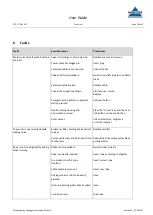
User Guide
TGT. 27.09.2017
Technical
Page 6 of 21
©Copyright by Habegger Maschinenfabrik AG
Version 01 / 27.09.2017
1
General specifications
The motor-driven rope pulling machine HIT-TRAC 32 is designed for pulling, hoisting and lowering loads.
1.1
Drive mechanism
A special HABEGGER steel cable of desired length which is guided over the relevant guide elements by the driving wheel and
then ejected in an unloaded state is used as the drive mechanism.
1.2
Housing cover
The removable cover on the driving wheel prevents the entry of foreign objects and protects against accidents resulting from
improper access. There is also an anti-derailment device for the traction cable integrated into the housing cover.
-
Close and secure the housing cover over the driving system before carrying out any work.
1.3
Rope
The machine is equipped for rope diameters of 16 mm in the factory.
This rope is suitable for all hoisting, pulling and lowering work.
-
Only suitable, original HABEGGER ropes should be used.
1.4
Operation
The machine is powered using a 3-phase rotary current motor
1.5
Electrical control system
On / off control
The machine is equipped with an on / off control as standard.
The contactor controls for hoisting and lowering are located in the control box which is permanently mounted to the motor.
The input comes from a plug for three-phase A.C. current along a 5m long supply cable. Also connected to the control box,
via a 3m long control cable, is a pendant station with the control buttons UP/DOWN and the emergency stop button.
Speed control
The machine can be fitted with a speed control.
This control is built the same way as a standard control but is also fitted with a frequency converter. This enable the rope
speed to be reduced using a potentiometer on the pendant station.
The rope speed can be set using the rotary switch on the pendant station.
Customised models
For special purposes a control cable or a radio control can be attached. On these occasions even closer attention should be
paid to the rope pulling machine during hoisting and lowering. The empty rope’s free exit and entry must be guaranteed.







































